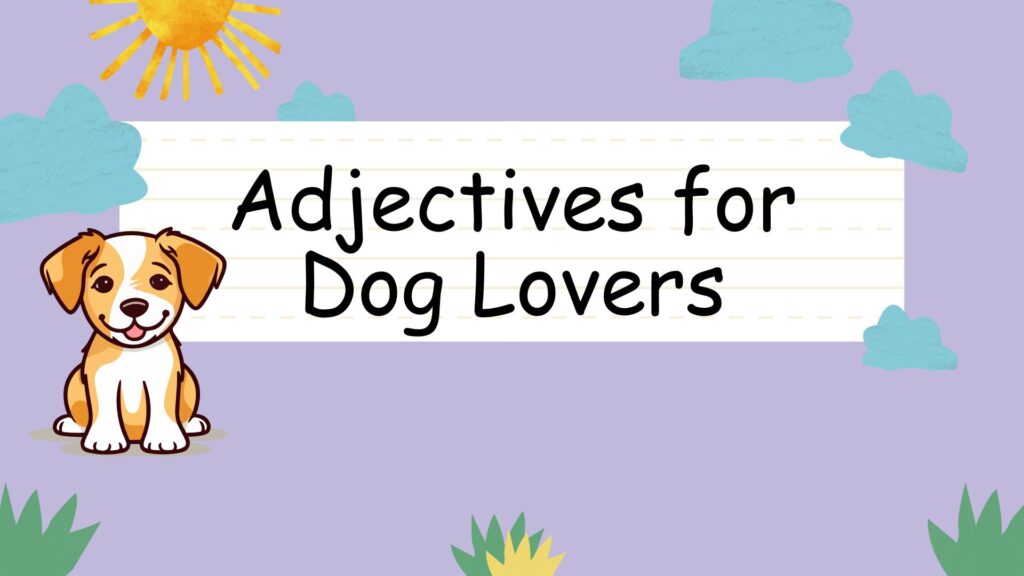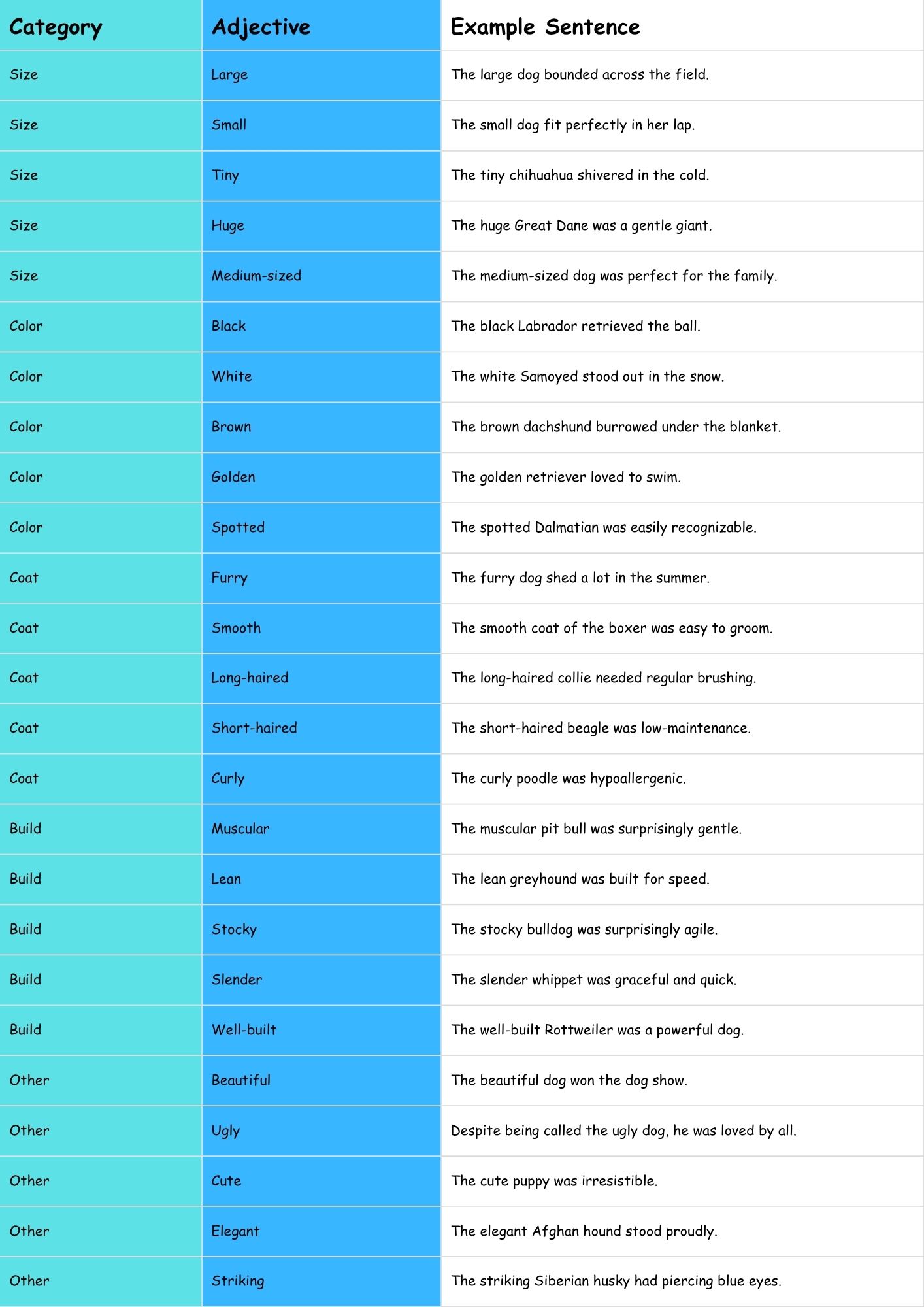Understanding how to use adjectives effectively is crucial for anyone who wants to communicate clearly and vividly about their canine companions. Adjectives bring life to our descriptions, allowing us to paint a detailed picture of a dog’s appearance, personality, and behavior. Whether you’re writing a story, describing your pet to a veterinarian, or simply chatting with fellow dog enthusiasts, mastering adjectives will significantly enhance your ability to express yourself. This article provides a comprehensive guide to using adjectives for dogs, suitable for English learners of all levels, from beginners to advanced speakers.
This guide will delve into the various types of adjectives, their proper usage, common mistakes to avoid, and plenty of practical examples. By the end of this article, you’ll be well-equipped to describe any dog, from a playful puppy to a wise old hound, with accuracy and flair.
Table of Contents
- Introduction
- Definition of Adjectives
- Structural Breakdown of Adjectives
- Types of Adjectives
- Examples of Adjectives for Dogs
- Usage Rules for Adjectives
- Common Mistakes with Adjectives
- Practice Exercises
- Advanced Topics
- FAQ
- Conclusion
Definition of Adjectives
An adjective is a word that modifies a noun or pronoun. It provides more information about the noun or pronoun, describing its qualities, characteristics, or attributes. Adjectives answer questions like “What kind?”, “Which one?”, “How many?”, or “How much?” They are essential for adding detail and clarity to our language.
In the context of describing dogs, adjectives are crucial for conveying specific details about their physical appearance (e.g., fluffy, small, brown), their personality traits (e.g., friendly, loyal, energetic), and their behavior (e.g., playful, obedient, mischievous). Without adjectives, our descriptions would be bland and lack the richness needed to truly capture the essence of a particular dog.
Adjectives can be classified based on their function and the type of information they provide. Understanding these different classifications can help you use adjectives more effectively and precisely.
Structural Breakdown of Adjectives
Adjectives typically precede the nouns they modify, but they can also follow linking verbs such as is, are, was, were, seem, and become. The position of the adjective can affect the emphasis and flow of the sentence.
Attributive Adjectives: These adjectives come before the noun they modify. For example, in the phrase “a fluffy dog,” the adjective “fluffy” is an attributive adjective because it comes before the noun “dog.”
Predicative Adjectives: These adjectives follow a linking verb and describe the subject of the sentence. For example, in the sentence “The dog is happy,” the adjective “happy” is a predicative adjective because it follows the linking verb “is” and describes the subject “dog.”
It’s important to note that some adjectives can function as both attributive and predicative adjectives, while others are typically used in only one position. For example, the adjective “old” can be used in both ways: “an old dog” (attributive) and “The dog is old” (predicative).
Types of Adjectives
There are several types of adjectives, each serving a different purpose in describing nouns. Understanding these types will help you choose the most appropriate adjectives to use in your descriptions.
Descriptive Adjectives
Descriptive adjectives, also known as qualitative adjectives, describe the qualities or characteristics of a noun. They answer the question “What kind?” These are the most common type of adjective and are essential for providing detailed descriptions.
Examples of descriptive adjectives for dogs include: large, small, furry, spotted, friendly, loyal, playful, energetic, intelligent, stubborn, happy, sad, brave, timid, vocal, quiet, gentle, protective, curious, and mischievous.
Quantitative Adjectives
Quantitative adjectives indicate the quantity or amount of a noun. They answer the question “How many?” or “How much?” These adjectives are often used to describe the number or amount of something.
Examples of quantitative adjectives include: one, two, three, few, many, several, some, all, no, enough, little, and much. For instance, “The dog ate several treats” or “There are few dogs in the park today.”
Demonstrative Adjectives
Demonstrative adjectives point out specific nouns. They answer the question “Which one?” The demonstrative adjectives are this, that, these, and those. They are always followed by a noun.
Examples of demonstrative adjectives include: This dog is mine, That dog is very friendly, These dogs are well-trained, and Those dogs are running in the field.
Possessive Adjectives
Possessive adjectives show ownership or possession. They indicate who or what owns the noun. The possessive adjectives are my, your, his, her, its, our, and their. They always precede a noun.
Examples of possessive adjectives include: My dog loves to play fetch, Your dog is very well-behaved, His dog is a golden retriever, Her dog is a small terrier, Its tail wags when it’s happy, Our dog is part of the family, and Their dog is always excited to see them.
Interrogative Adjectives
Interrogative adjectives are used to ask questions about a noun. The interrogative adjectives are what, which, and whose. They are always followed by a noun.
Examples of interrogative adjectives include: What dog breed is that?, Which dog won the competition?, and Whose dog is barking so loudly?
Proper Adjectives
Proper adjectives are formed from proper nouns. They describe a noun by indicating its origin, nationality, or type. Proper adjectives are always capitalized.
Examples of proper adjectives include: German Shepherd (from Germany), French Bulldog (from France), Italian Greyhound (from Italy), and American Eskimo Dog (from America).
Compound Adjectives
Compound adjectives are formed by combining two or more words, often connected by a hyphen. They function as a single adjective to describe a noun.
Examples of compound adjectives include: well-behaved dog, short-haired dog, long-legged dog, blue-eyed dog, good-natured dog, three-year-old dog, and easy-going dog.
Examples of Adjectives for Dogs
To further illustrate the use of adjectives, here are several examples categorized by the aspect of the dog they describe.
Adjectives Describing Appearance
This table provides examples of adjectives used to describe a dog’s physical appearance, covering various aspects such as size, color, coat, and overall build. These adjectives help create a vivid picture of the dog’s looks.
| Category | Adjective | Example Sentence |
|---|---|---|
| Size | Large | The large dog bounded across the field. |
| Size | Small | The small dog fit perfectly in her lap. |
| Size | Tiny | The tiny chihuahua shivered in the cold. |
| Size | Huge | The huge Great Dane was a gentle giant. |
| Size | Medium-sized | The medium-sized dog was perfect for the family. |
| Color | Black | The black Labrador retrieved the ball. |
| Color | White | The white Samoyed stood out in the snow. |
| Color | Brown | The brown dachshund burrowed under the blanket. |
| Color | Golden | The golden retriever loved to swim. |
| Color | Spotted | The spotted Dalmatian was easily recognizable. |
| Coat | Furry | The furry dog shed a lot in the summer. |
| Coat | Smooth | The smooth coat of the boxer was easy to groom. |
| Coat | Long-haired | The long-haired collie needed regular brushing. |
| Coat | Short-haired | The short-haired beagle was low-maintenance. |
| Coat | Curly | The curly poodle was hypoallergenic. |
| Build | Muscular | The muscular pit bull was surprisingly gentle. |
| Build | Lean | The lean greyhound was built for speed. |
| Build | Stocky | The stocky bulldog was surprisingly agile. |
| Build | Slender | The slender whippet was graceful and quick. |
| Build | Well-built | The well-built Rottweiler was a powerful dog. |
| Other | Beautiful | The beautiful dog won the dog show. |
| Other | Ugly | Despite being called the ugly dog, he was loved by all. |
| Other | Cute | The cute puppy was irresistible. |
| Other | Elegant | The elegant Afghan hound stood proudly. |
| Other | Striking | The striking Siberian husky had piercing blue eyes. |
Adjectives Describing Personality
This table provides examples of adjectives used to describe a dog’s personality traits. These adjectives help convey the dog’s temperament, disposition, and overall character.
| Category | Adjective | Example Sentence |
|---|---|---|
| Temperament | Friendly | The friendly dog greeted everyone with a wagging tail. |
| Temperament | Loyal | The loyal dog stayed by her side through everything. |
| Temperament | Gentle | The gentle dog was great with children. |
| Temperament | Affectionate | The affectionate dog loved to cuddle. |
| Temperament | Calm | The calm dog rarely barked or got excited. |
| Disposition | Playful | The playful dog loved to chase balls. |
| Disposition | Energetic | The energetic dog needed a lot of exercise. |
| Disposition | Curious | The curious dog explored every corner of the house. |
| Disposition | Mischievous | The mischievous dog often got into trouble. |
| Disposition | Happy | The happy dog always had a smile on his face. |
| Character | Intelligent | The intelligent dog learned new tricks quickly. |
| Character | Brave | The brave dog protected his family from danger. |
| Character | Timid | The timid dog was afraid of loud noises. |
| Character | Stubborn | The stubborn dog was difficult to train. |
| Character | Independent | The independent dog preferred to do things on his own. |
| Character | Protective | The protective dog guarded his home fiercely. |
| Character | Alert | The alert dog barked at any unusual sound. |
| Character | Easy-going | The easy-going dog got along with everyone. |
| Character | Sensitive | The sensitive dog was easily hurt by harsh words. |
| Character | Confident | The confident dog strutted around the park. |
| Other | Sweet | The sweet dog was a joy to be around. |
| Other | Kind | The kind dog comforted those in need. |
| Other | Loving | The loving dog showered everyone with affection. |
| Other | Good-natured | The good-natured dog never showed aggression. |
| Other | Charming | The charming dog won everyone over with his personality. |
Adjectives Describing Behavior
This table provides examples of adjectives used to describe a dog’s behavior. These adjectives help illustrate how the dog acts in different situations and its typical habits.
| Category | Adjective | Example Sentence |
|---|---|---|
| Habits | Playful | The playful dog loved to chase his tail. |
| Habits | Obedient | The obedient dog followed every command. |
| Habits | Destructive | The destructive dog chewed on everything he could find. |
| Habits | Active | The active dog needed a lot of exercise. |
| Habits | Lazy | The lazy dog spent most of the day sleeping. |
| Reactions | Aggressive | The aggressive dog barked at strangers. |
| Reactions | Friendly | The friendly dog wagged his tail at everyone he met. |
| Reactions | Fearful | The fearful dog hid under the bed during thunderstorms. |
| Reactions | Excited | The excited dog jumped up and down when his owner came home. |
| Reactions | Calm | The calm dog remained composed even in stressful situations. |
| Training | Well-trained | The well-trained dog performed tricks on command. |
| Training | Untrained | The untrained dog ran wild in the park. |
| Training | Responsive | The responsive dog learned quickly and easily. |
| Training | Unresponsive | The unresponsive dog ignored commands. |
| Training | Teachable | The teachable dog was a joy to train. |
| Vocalization | Vocal | The vocal dog barked at everything that moved. |
| Vocalization | Quiet | The quiet dog rarely made a sound. |
| Vocalization | Barking | The barking dog alerted the neighborhood to danger. |
| Vocalization | Whining | The whining dog wanted attention. |
| Vocalization | Howling | The howling dog responded to the sirens. |
| Other | Energetic | The energetic dog ran around all day |
| Other | Mischievous | The mischievous dog stole the sandwich. |
| Other | Loving | The loving dog always sits on my feet. |

Usage Rules for Adjectives
Using adjectives correctly involves understanding their order, comparative and superlative forms, and how to handle coordinate adjectives.
Adjective Order
When using multiple adjectives to describe a noun, there is a general order to follow. This order is not a strict rule, but it helps ensure that your descriptions sound natural and clear. The typical order is:
- Opinion: beautiful, ugly, interesting
- Size: large, small, tiny
- Age: old, young, new
- Shape: round, square, triangular
- Color: black, white, blue
- Origin: German, French, American
- Material: wooden, metal, plastic
- Purpose: running, sleeping, hunting
For example:
- A beautiful large old dog (opinion, size, age)
- A small black German dog (size, color, origin)
- An old wooden dog house (age, material)
It’s important to note that you don’t always need to use all these categories. Choose the adjectives that best describe the noun you are writing about and arrange them in the most logical order.
Comparative and Superlative Adjectives
Comparative adjectives are used to compare two nouns, while superlative adjectives are used to compare three or more nouns. The forms of comparative and superlative adjectives depend on the length of the adjective.
Short Adjectives (one syllable): Add “-er” for the comparative form and “-est” for the superlative form.
- Tall: taller, tallest
- Small: smaller, smallest
- Fast: faster, fastest
For example:
- This dog is taller than that dog.
- This is the smallest dog I have ever seen.
- The greyhound is the fastest breed of dog.
Long Adjectives (two or more syllables): Use “more” for the comparative form and “most” for the superlative form.
- Beautiful: more beautiful, most beautiful
- Intelligent: more intelligent, most intelligent
- Energetic: more energetic, most energetic
For example:
- This dog is more intelligent than that dog.
- This is the most beautiful dog in the show.
- The border collie is the most energetic breed of dog.
Irregular Adjectives: Some adjectives have irregular comparative and superlative forms.
- Good: better, best
- Bad: worse, worst
- Far: farther/further, farthest/furthest
For example:
- This dog is better behaved than that dog.
- This is the best dog I have ever owned.
- This dog lives farther away than that dog.
Coordinate Adjectives
Coordinate adjectives are two or more adjectives that modify the same noun and are equal in importance. You should separate coordinate adjectives with a comma.
To determine if adjectives are coordinate, you can try inserting “and” between them. If the sentence still makes sense, the adjectives are coordinate. You can also try reversing the order of the adjectives. If the sentence still makes sense, they are coordinate.
For example:
- A loyal, friendly dog (loyal and friendly both describe the dog).
- A large, playful puppy (large and playful both describe the puppy).
However, if the adjectives are not coordinate, do not use a comma.
For example:
- A small black dog (black describes the type of small dog).
- An old wooden dog house (wooden describes the type of old dog house).
Common Mistakes with Adjectives
Here are some common mistakes to avoid when using adjectives:
| Mistake | Incorrect Example | Correct Example |
|---|---|---|
| Misusing comparative/superlative forms | This dog is more taller than that dog. | This dog is taller than that dog. |
| Using “most” with short adjectives | This is the most smallest dog I’ve seen. | This is the smallest dog I’ve seen. |
| Incorrect adjective order | A black small dog. | A small black dog. |
| Missing commas between coordinate adjectives | A loyal friendly dog. | A loyal, friendly dog. |
| Using adjectives as adverbs | The dog runs quick. | The dog runs quickly. |
| Using double comparatives/superlatives | This dog is more friendlier than that dog. | This dog is friendlier than that dog. |
Practice Exercises
Test your understanding of adjectives with these exercises.
Exercise 1: Identifying Adjectives
Underline the adjectives in the following sentences.
| Question | Answer |
|---|---|
| 1. The fluffy dog played with the red ball. | fluffy, red |
| 2. The loyal companion followed his owner everywhere. | loyal |
| 3. The small terrier had a big personality. | small, big |
| 4. The energetic puppy needed a long walk. | energetic |
| 5. The gentle giant was great with children. | gentle |
| 6. The black Labrador swam in the clear lake. | black, clear |
| 7. The brave dog protected his family from danger. | brave |
| 8. The mischievous dog stole the sandwich from the table. | mischievous |
| 9. The obedient dog followed every command. | obedient |
| 10. The curious dog explored every corner of the house. | curious |
Exercise 2: Using Comparative and Superlative Adjectives
Fill in the blanks with the correct comparative or superlative form of the adjective in parentheses.
| Question | Answer |
|---|---|
| 1. This dog is ______ (tall) than that dog. | taller |
| 2. This is the ______ (small) dog I have ever seen. | smallest |
| 3. The border collie is ______ (intelligent) than the bulldog. | more intelligent |
| 4. This is the ______ (beautiful) dog in the show. | most beautiful |
| 5. The greyhound is the ______ (fast) breed of dog. | fastest |
| 6. This dog is ______ (good) at fetching than the other one. | better |
| 7. This movie featuring dogs is the ______ (bad) movie I’ve ever seen. | worst |
| 8. This dog lives ______ (far) away than that dog. | farther |
| 9. This dog is ______ (energetic) than that dog. | more energetic |
| 10. He is the ______ (brave) dog I know. | bravest |
Exercise 3: Adjective Order
Rewrite the following phrases with the adjectives in the correct order.
| Question | Answer |
|---|---|
| 1. A black small dog | A small black dog |
| 2. A wooden old dog house | An old wooden dog house |
| 3. A playful large puppy | A large playful puppy |
| 4. A white fluffy big dog | A big fluffy white dog |
| 5. A German young Shepherd | A young German Shepherd |
| 6. A brown little cute dog | A cute little brown dog |
| 7. An energetic old terrier | An old energetic terrier |
| 8. A friendly big golden retriever | A big friendly golden retriever |
| 9. A stubborn small dachshund | A small stubborn dachshund |
| 10. A black sleek beautiful cat | A beautiful sleek black cat |
Advanced Topics
For advanced learners, consider exploring these more complex aspects of adjectives:
- Adjective Clauses: These are dependent clauses that function as adjectives, modifying nouns or pronouns. For example, “The dog that won the competition is a German Shepherd.”
- Participle Adjectives: These are adjectives formed from verbs, either in the present participle (ending in “-ing”) or past participle (ending in “-ed”). For example, “The barking dog woke up the neighbors” (present participle) and “The trained dog performed tricks” (past participle).
- Nominal Adjectives: In some cases, adjectives can function as nouns, referring to a general group of people or things. For example, “The elderly often appreciate the companionship of dogs.”
FAQ
Here are some frequently asked questions about using adjectives:
- What is the difference between an adjective and an adverb?Adjectives modify nouns or pronouns, while adverbs modify verbs, adjectives, or other adverbs. Adjectives describe what something is, while adverbs describe how something is done.
- Can a noun be used as an adjective?Yes, nouns can sometimes function as adjectives, modifying other nouns. This is called a noun adjunct or attributive noun. For example, “dog food” (dog is a noun modifying food).
- How do I know when to use a comma between adjectives?Use a comma between coordinate adjectives, which are adjectives that independently modify the same noun and are equal in importance. You can test if adjectives are coordinate by inserting “and” between them or reversing their order. If the sentence still makes sense, use a comma.
- What are some common suffixes used to form adjectives?Common suffixes for forming adjectives include “-ful” (e.g., beautiful), “-less” (e.g., fearless), “-able” (e.g., teachable), “-ible” (e.g., responsible), “-ous” (e.g., curious), “-ive” (e.g., active), and “-y” (e.g., furry).
- Can I use too many adjectives in a sentence?Yes, using too many adjectives can make your writing sound cluttered and unnatural. Choose adjectives carefully and use only those that add significant detail and clarity.
- What if I can’t remember the correct order of adjectives?While there is a general order, it is not a strict rule. Focus on choosing the adjectives that best describe the noun and arranging them in a way that sounds natural and clear. When in doubt, simplify the sentence by using fewer adjectives.
- Are there any adjectives that should be avoided when describing dogs?It’s generally best to avoid overly subjective or potentially offensive adjectives. Focus on descriptive and objective terms that accurately convey the dog’s appearance, personality, and behavior. Avoid generalizations or stereotypes about specific breeds.
- How
do I improve my vocabulary of adjectives?Reading widely, using a thesaurus, and practicing writing descriptions are all effective ways to improve your vocabulary of adjectives. Make a habit of noting down new adjectives you encounter and using them in your own writing. - Where can I find more examples of adjectives used to describe dogs?You can find more examples in books, articles, and websites about dogs, as well as in online forums and communities dedicated to dog lovers. Pay attention to how different writers and speakers describe dogs and note the adjectives they use.
Conclusion
Mastering the use of adjectives is essential for anyone who wants to describe dogs accurately and vividly. By understanding the different types of adjectives, their proper usage, and common mistakes to avoid, you can significantly enhance your ability to communicate about your canine companions. Whether you’re describing their appearance, personality, or behavior, choosing the right adjectives will bring your descriptions to life and allow others to see and appreciate the unique qualities of each dog.
Continue to practice using adjectives in your writing and speaking, and don’t be afraid to experiment with different combinations to find the most effective ways to express yourself. With a little effort and attention, you’ll become a master of adjectives and a more skilled communicator about all things dog-related.




